
Toucans thrive across Costa Rica’s diverse habitats, from lowland rainforests to cloud forests and even some open woodlands, as you mentioned. They’re often found near fruit trees, which make up the bulk of their diet. Your article lists rainforests, savannas, and forests, but savannas are less common for toucans in Costa Rica, where they prefer dense, humid forests like those in Tortuguero or Monteverde. They’re also spotted in secondary forests and forest edges, where fruit is plentiful.
These birds are omnivores, eating fruits like figs and berries, insects, small lizards, and even bird eggs. They live in small groups, or “bands,” of up to 20 birds, as you noted, and their honking calls echo through the canopy. Your article repeats this social behavior for each species, so we’ll streamline that here: all toucans are social, vocal, and agile, using their strong legs to hop between branches rather than relying on flight.
Toucan Species in Costa Rica: A Colorful Cast
Costa Rica is home to six toucan species, not just the three you listed. Here’s a rundown of the main players, correcting some details and adding the missing ones
Keel-Billed Toucan
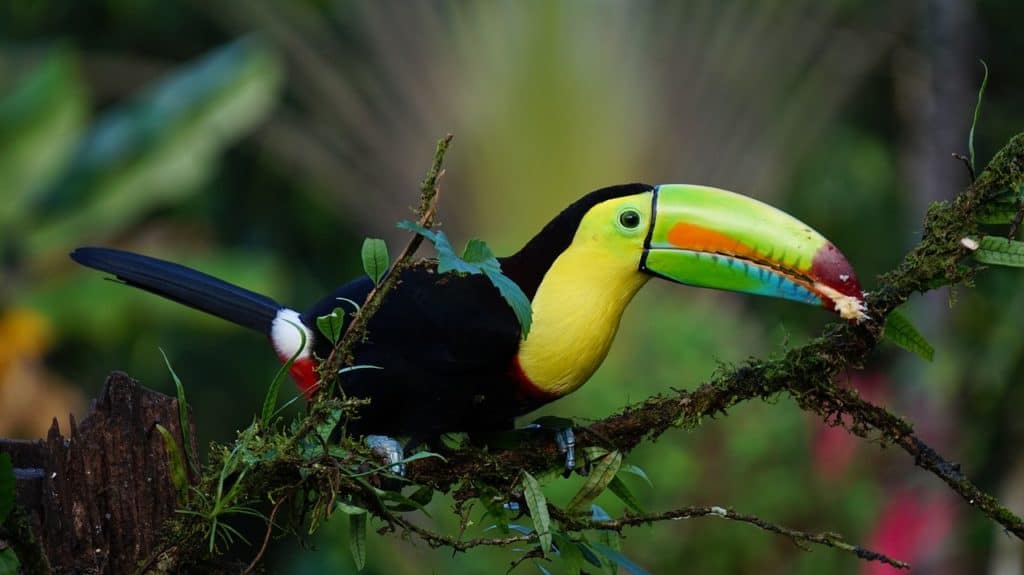
The Keel-billed toucan, often called the rainbow-billed toucan, is a showstopper with its massive, multicolored beak—green at the base, blue in the middle, red at the tip, and orange on the sides. Its body is mostly black, with a bright yellow chest and red under the tail. Growing to about 50–55 cm (20–22 inches), it’s one of the larger toucans in Costa Rica. The beak, despite its size, is lightweight, made of a spongy material that helps regulate body temperature.
You’ll find Keel-billed toucans in lowland rainforests and forest edges, from Tortuguero on the Caribbean side to Corcovado on the Pacific. They eat mostly fruits like figs and berries, but also snack on insects, small lizards, and bird eggs. They live in small groups of 6–12, called bands, and are chatty, making loud, frog-like croaks or honking calls that carry through the canopy. They’re agile, hopping between branches rather than flying long distances.
These toucans are key seed dispersers, spreading seeds of fruit trees like cecropia, which helps forests regenerate. They’re common in places like La Selva Biological Station and a major draw for birdwatchers, but habitat loss in some areas puts pressure on their populations. The IUCN lists them as “least concern,” but conservation is key to keeping their forests intact.
Emerald Toucanet
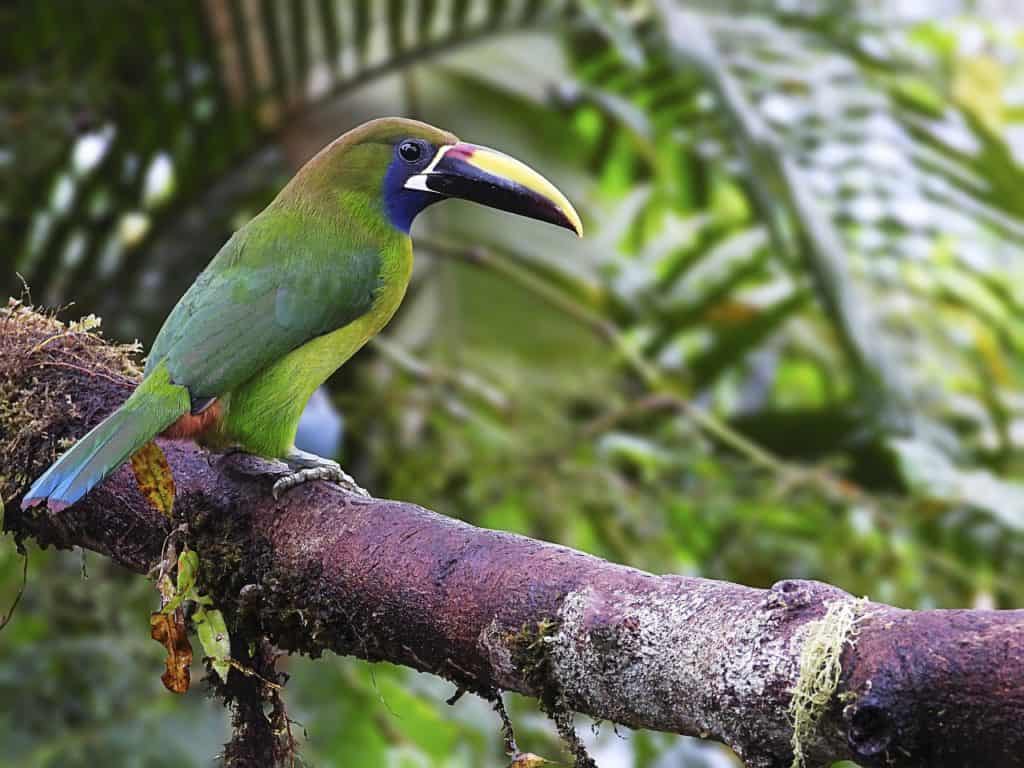
The Emerald toucanet is the smallest of Costa Rica’s toucans, measuring 30–35 cm (12–14 inches). Its bright green feathers make it blend into the forest, but the black head, yellow-tipped black beak, and white throat patch stand out. Unlike larger toucans, it has a more compact build, perfect for navigating dense foliage.
You’ll find Emerald toucanets in cloud forests and highland forests, like Monteverde and Braulio Carrillo National Park, at elevations of 800–2,500 meters. They eat fruits, insects, and small lizards, often foraging in pairs or small groups of 3–6 birds. Their calls are sharp whistles or soft chirps, less loud than their bigger cousins. They’re agile climbers, darting through branches to find food.
These toucanets are crucial for dispersing seeds in high-altitude forests, where fewer animals play this role. They’re a treat to spot on Monteverde’s hanging bridges, but their habitat is shrinking due to agriculture. The IUCN lists them as “least concern,” but some subspecies face risks from habitat loss, so conservation efforts in cloud forests are critical.
Chestnut-Mandibled Toucan
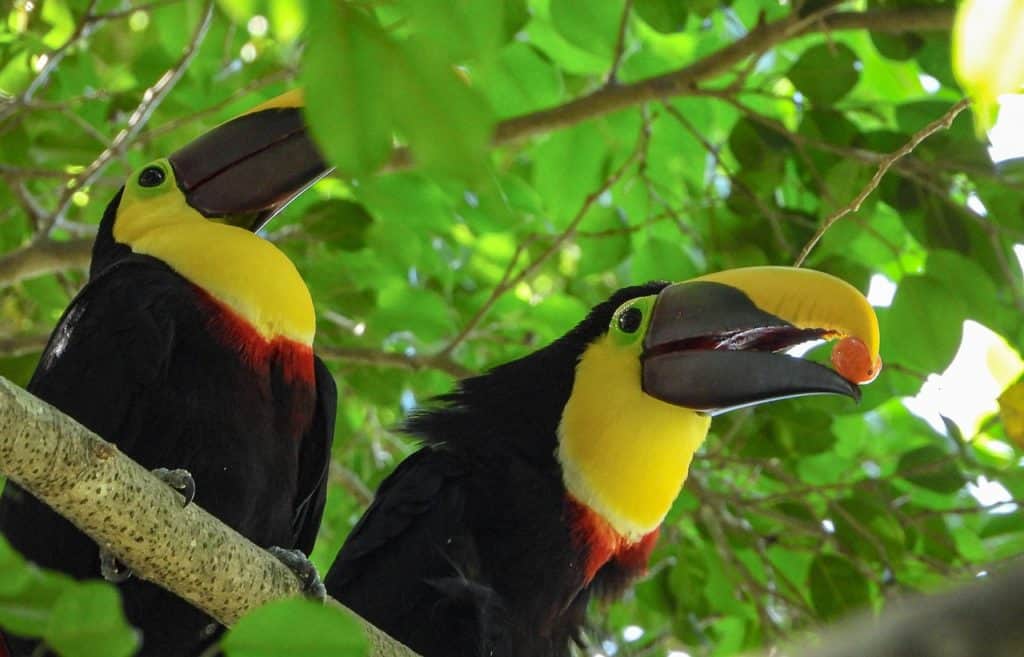
Also known as the Yellow-throated toucan, the Chestnut-mandibled toucan is another big bird, reaching 52–56 cm (21–22 inches). Its beak is a striking mix of yellow on top, dark chestnut below, and a white patch at the base that looks like a mustache. The body is black with a yellow throat, red under the tail, and green around the eyes. It’s one of the heaviest toucans in Costa Rica, with a robust build.
This species hangs out in rainforests and forest edges, from Manuel Antonio to the Osa Peninsula, mostly on the Pacific slope. Like other toucans, it eats fruits, insects, and small reptiles, using its beak to pluck berries or snatch bugs mid-air. It lives in bands of up to 10 birds, and its calls are deep, yelping honks that echo in the forest. They’re not great fliers, preferring to hop from branch to branch.
Chestnut-mandibled toucans help forests grow by scattering seeds, especially of large fruit trees. They also control insect populations, eating pests like caterpillars. You can spot them in Carara National Park, where they’re a favorite on birding tours. They’re listed as “least concern” by the IUCN, but deforestation threatens their habitat, making protected areas vital.
Fiery-Billed Aracari (Pteroglossus frantzii)
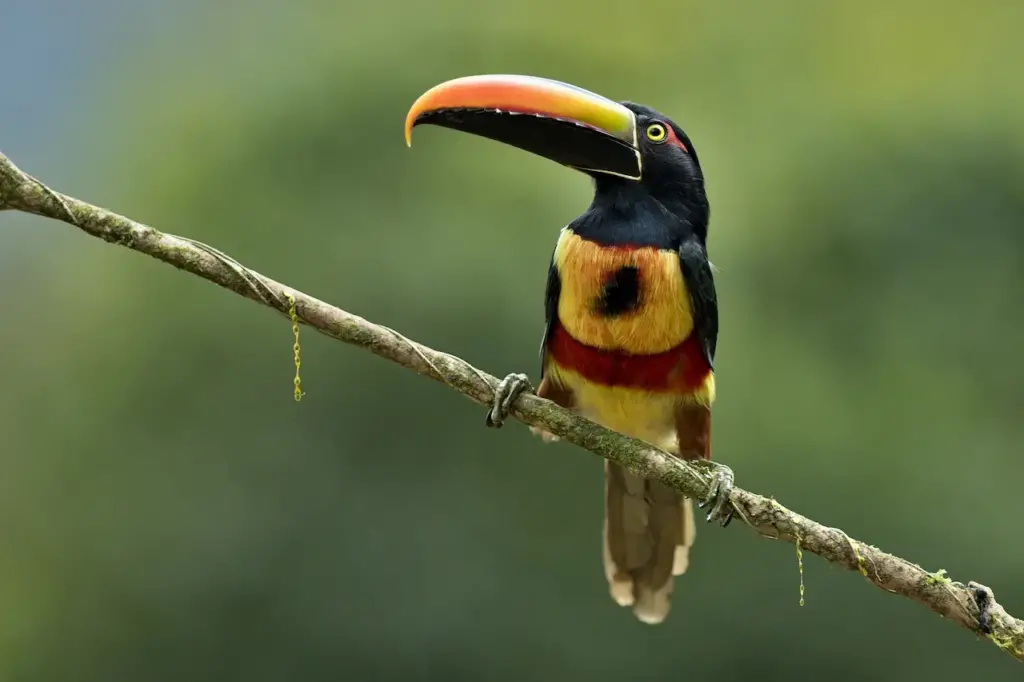
The Fiery-billed aracari is a medium-sized toucan, about 40–45 cm (16–18 inches), with a fiery orange-red beak that gives it its name. Its feathers are black on the back, yellow on the chest, and red on the belly, with a distinctive green eye ring. It’s slimmer than true toucans, with a more pointed beak.
This species lives in Pacific slope forests, from Carara to the Nicoya Peninsula, preferring lowland rainforests and forest edges. It eats fruits, insects, and small vertebrates, often raiding other birds’ nests for eggs. Fiery-billed aracaris travel in bands of 5–10, making high-pitched, squeaky calls. They’re active foragers, poking into tree crevices for bugs.
They spread seeds of fruit trees, aiding forest growth, and control insect populations. Spot them in Palo Verde National Park, where their bright beaks flash in the canopy. They’re “least concern” per the IUCN, but deforestation and farmland expansion threaten their range, making reserves like Carara essential.
Collared Aracari (Pteroglossus torquatus)
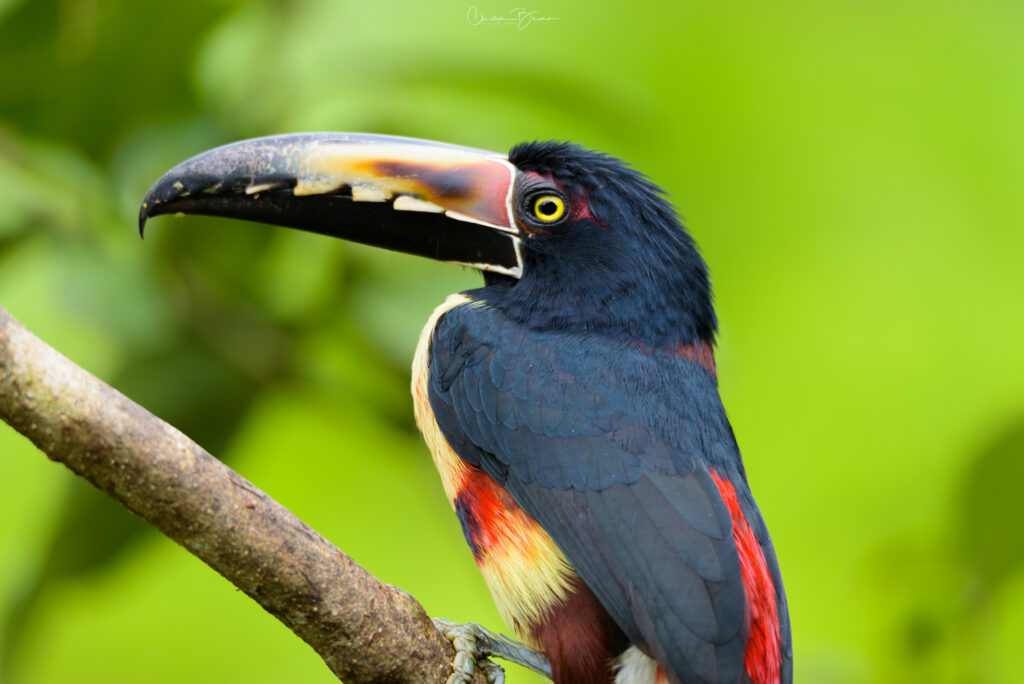
The Collared aracari, also 38–43 cm (15–17 inches), has a black beak with red spots and a red chest that looks like a collar. Its feathers are black above, yellow below, with green and red accents. It’s similar to the Fiery-billed but found on the Caribbean side, in lowlands like Tortuguero and Cahuita.
Collared aracaris eat fruits, insects, and small reptiles, foraging in groups of 6–15. Their calls are sharp, chattering squeaks, often heard at dawn. They’re nimble, hopping through trees or hanging upside down to grab berries. You’ll see them in dense rainforests or even near banana plantations, where fruit is abundant.
They’re vital seed dispersers, especially for pioneer trees that regrow cleared areas. They also eat pest insects, helping farmers. Birdwatchers love them in La Selva Biological Station, but habitat loss from logging is a concern. The IUCN lists them as “least concern,” but protecting Caribbean forests is key to their survival.
Yellow-Eared Toucanet (Selenidera spectabilis)

The Yellow-eared toucanet is the rarest of Costa Rica’s toucans, about 35–40 cm (14–16 inches). It has a black beak with yellow markings, black feathers, and bright yellow patches behind the eyes that look like ears. Females are duller, with more brown tones. It’s less flashy but striking up close.
This species lives in northern rainforests, like those near La Selva and Rara Avis, at low to mid-elevations. It eats fruits, insects, and small frogs, foraging alone or in pairs, unlike the larger bands of other toucans. Its calls are soft, croaking notes, hard to hear over forest noise. They’re shy, sticking to dense canopy.
Yellow-eared toucanets spread seeds in their limited range, supporting rare forest types. They’re tough to spot, even for seasoned birders, due to their elusive nature. The IUCN lists them as “near threatened” because of their small range and deforestation, so places like La Selva are critical for their survival.
Why These Toucans Matter
All six toucan species help Costa Rica’s forests thrive by spreading seeds, controlling pests, and creating nesting sites in tree hollows. They’re also a huge draw for ecotourism, bringing in millions through birdwatching tours and eco-lodges.
However, habitat loss, especially in lowland and northern forests, threatens their populations, particularly the Yellow-eared toucanet. Costa Rica’s protected areas and reforestation efforts are vital to keeping these birds around for future generations.
If you’re heading to Costa Rica, grab some binoculars and visit Corcovado for Keel-billed toucans, Monteverde for Emerald toucanets, or Carara for Fiery-billed aracaris. Early mornings are your best bet, and a local guide can point you to the right trees. These toucans aren’t just beautiful—they’re a big part of what makes Costa Rica’s forests so special.

